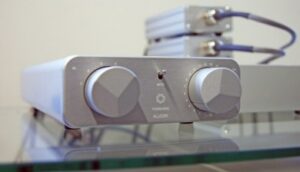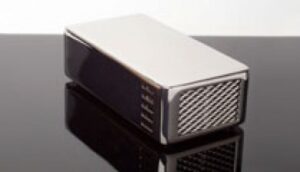HiFi Choice Award Edition 2011 – Strictly for the bats?

[column col=”1/2″]
To extend high-frequency reproduction to 100kHz seems batty, but says Jimmy Hughes, Townshend’s Super Tweeter is supersonic.
The case for subwoofers is fairly easy to make. Most loudspeakers are limited in terms of size and this leads to restricted bass depth. Very few can reproduce frequencies much deeper than 30Hz (and many don’t even get that far), so there’s an obvious need for something to reproduce those lower octaves.
Now you might expect a set of super tweeters to increase sharpness and give the sound greater upper-frequency immediacy and impact. This it does, but-and here’s where it gets a bit scary-you also notice improvements in apparent bass depth, along with increased lower-frequency tightness and control. Amazing! Subjectively, it’s akin to the way a good subwoofer makes the treble seems smoother and more ‘airy’, increasing the impression of 30 spacious depth and tonal richness. Although you’re only bolstering the lowest frequencies, the improvement seems to come in the midband and treble areas.
In much the same way, a good super tweeter seems to give you a tighter; cleaner bass, with reduced boom and overhang. Yet, turn off your main speakers and listen only to what ti1e super tweeter’s are doing-the noises they’re actually making -and it seems incredible that it could be making this sort of difference. One of the key aspects of getting great results from a subwoofer is-don’t have it up too loud. When you first get a sub, there’s a tendency to adjust it so its contribution is ‘obvious’. But paradoxically, subs produce their most profound effects when their presence is subliminal. You should only notice a sub when it’s switched off.
It’s exactly the same with a super tweeter; you need very little. Indeed, it’s been our experience (going back more than twenty years) that the less you have, the more profound the overall effect on sound quality becomes. We always use our Townshend Super Tweeters with them set to ’1?, and often wish there was a lower setting.
[/column]
[column col=”1/2″] Discretion pays
The question is -how and why do super tweeters (and subs) contribute so much, yet (apparently) seem to do so little? In our view, it’s to do with being able to move air at sub-sonic and supersonic frequencies, making it easier for frequencies in the audible range to couple-better to the air. By setting the air in motion at extremely high or low frequencies, you help the drive units to move the air in the middle-frequency areas where the bulk of the sound is.
Imagine a sharp blade trying to cut through something stiff. If you were to vibrate it at supersonic frequencies, it would cut more efficiently.
For this reason, you don’t actually have to ‘hear’ the contribution made by your super tweeters to notice the effect they have on the overall sound. Indeed, if the contribution is too strong, the result is counter-productive – the sound becomes messy and harsh, with excessive high-frequency emphasis.
When a super tweeter seamlessly integrates, you get a focused quality of sound that has an innate clarity, while also displaying a spacious airy quality that creates holographic 3D ‘out of the boxes’ stereo imagery. Transients have increased attack, yet the treble itself is effortlessly smooth and open. Given that most loudspeakers are more obviously deficient at the extreme low-frequency end of the spectrum, a good subwoofer probably gives you a bigger bang for your buck.
But a super tweeter like Townshend’s Maximum is likewise capable of adding an extra dimension that has to be heard to be believed.
Townshend Maximum Super Tweeters are capable of having a profound effect on sound quality -and not necessarily in ways you might expect or predict.
A hi·fi enthusiast for four decades, Jimmy’s knowledge of system-matching and record-collecting are unmatched in the industry.
[/column]
[column col=”1/1″]
[divider]
[space height=”20″]
[/column]








